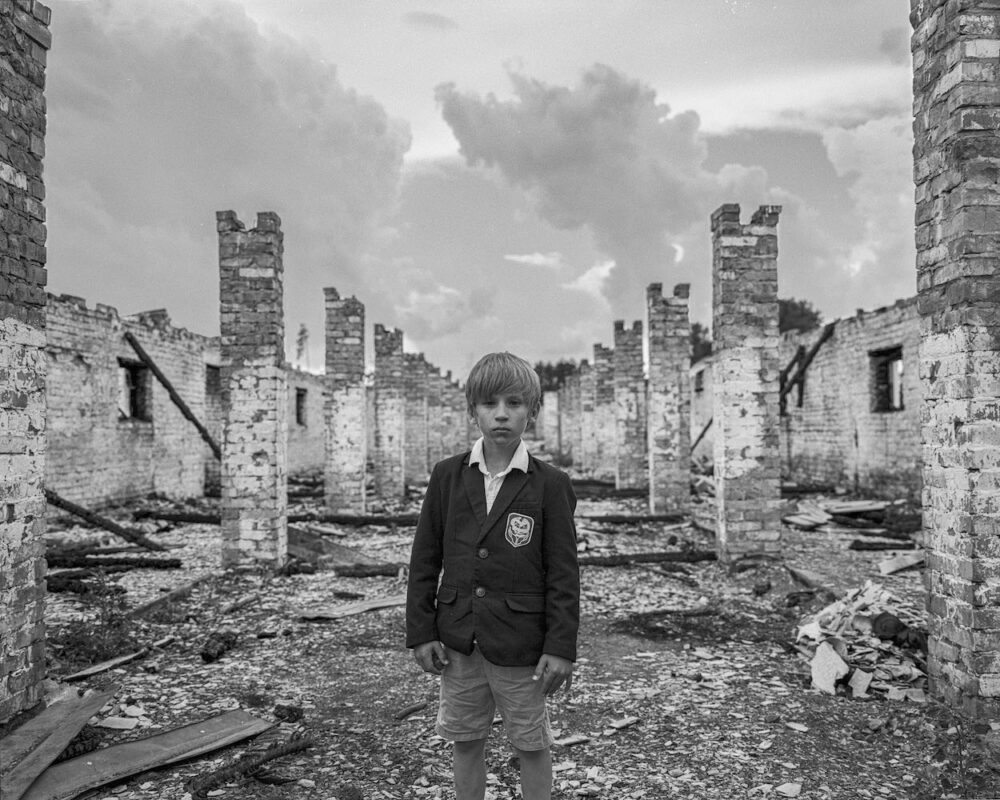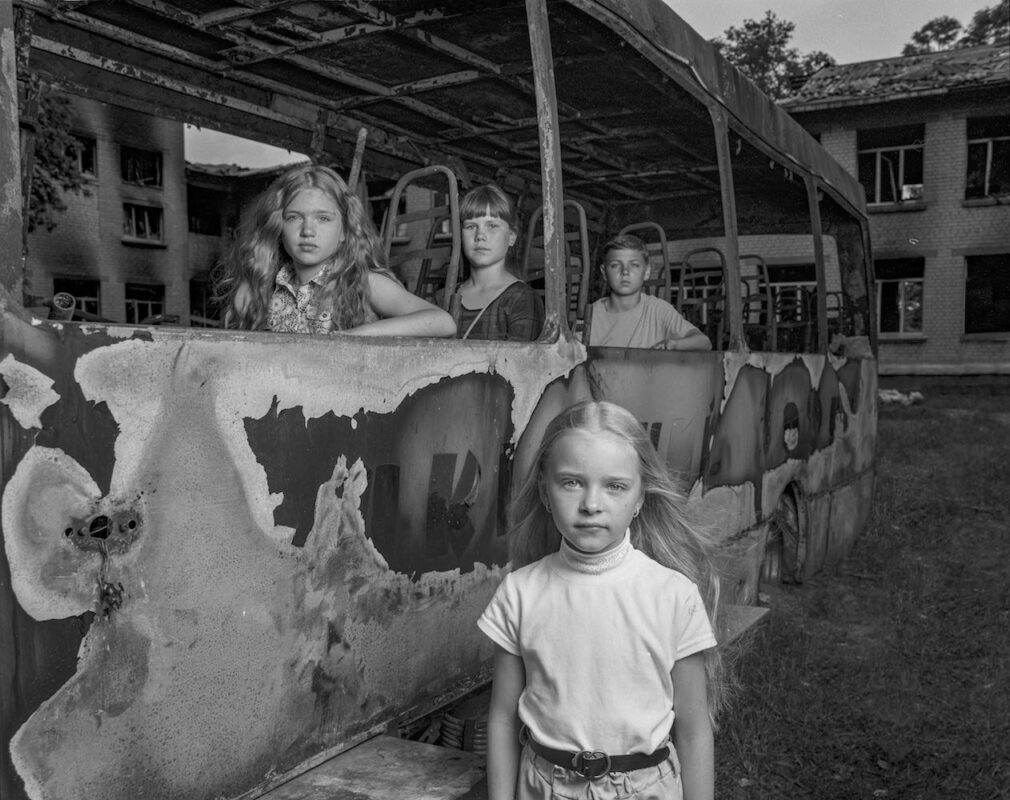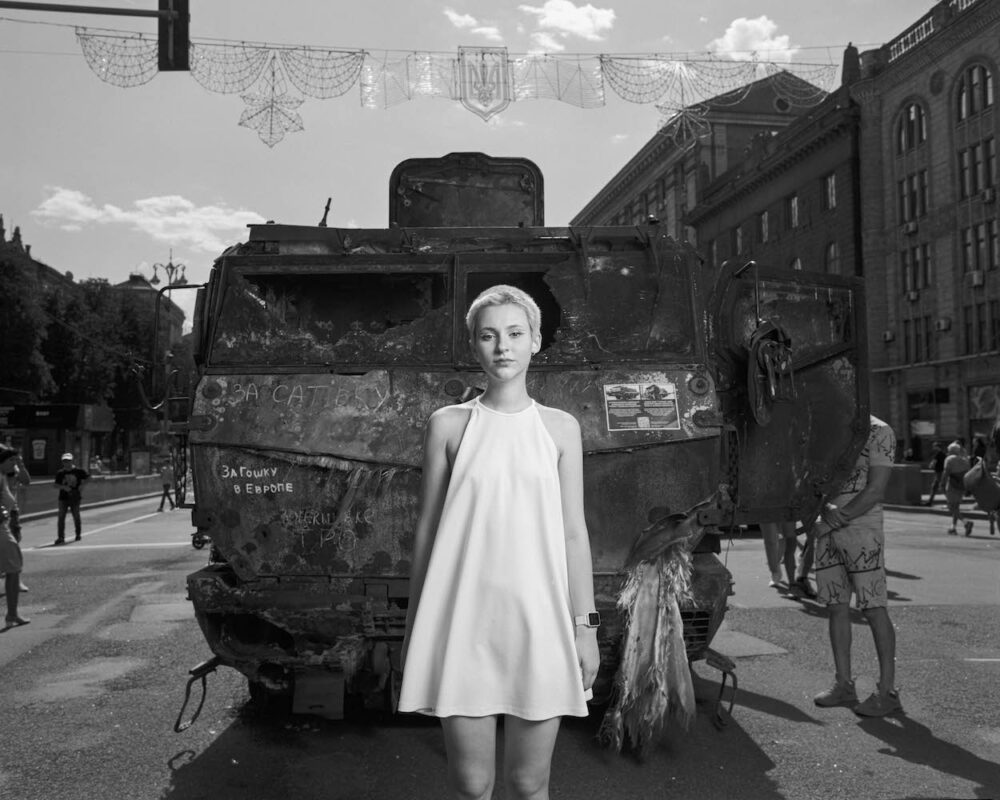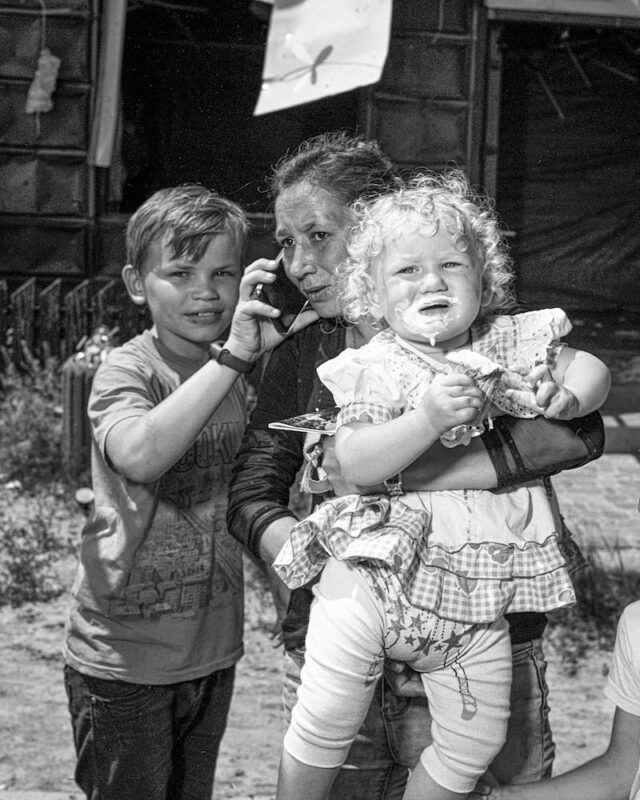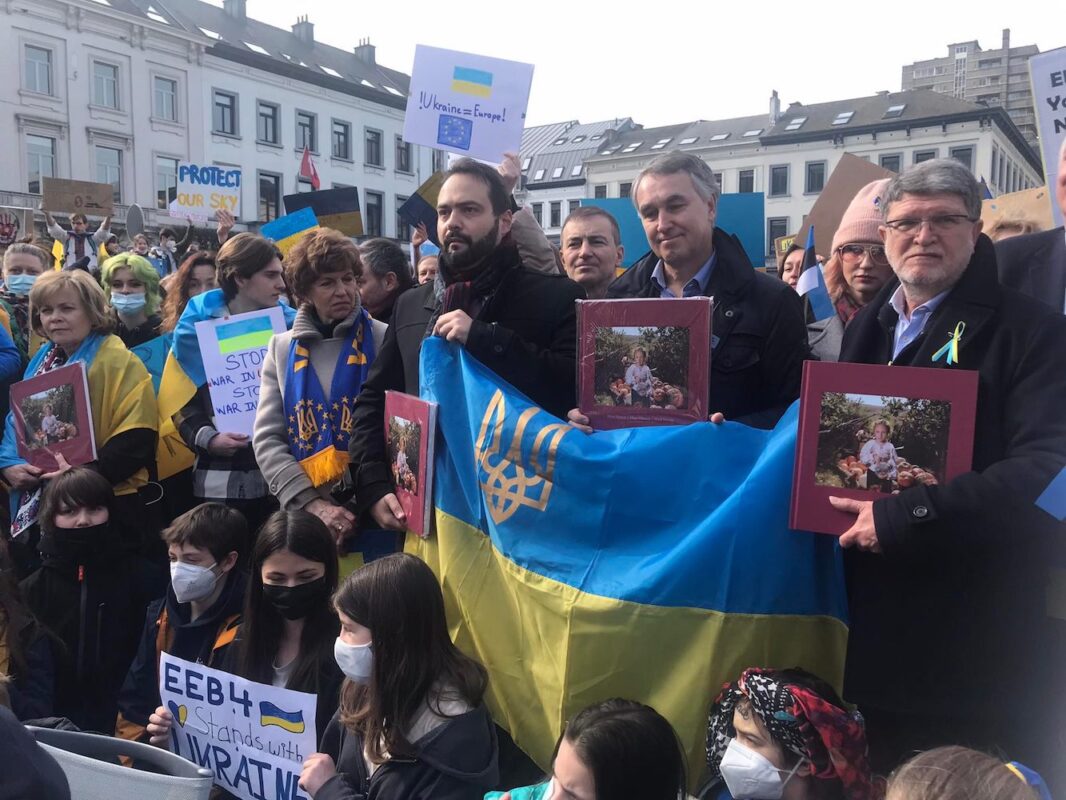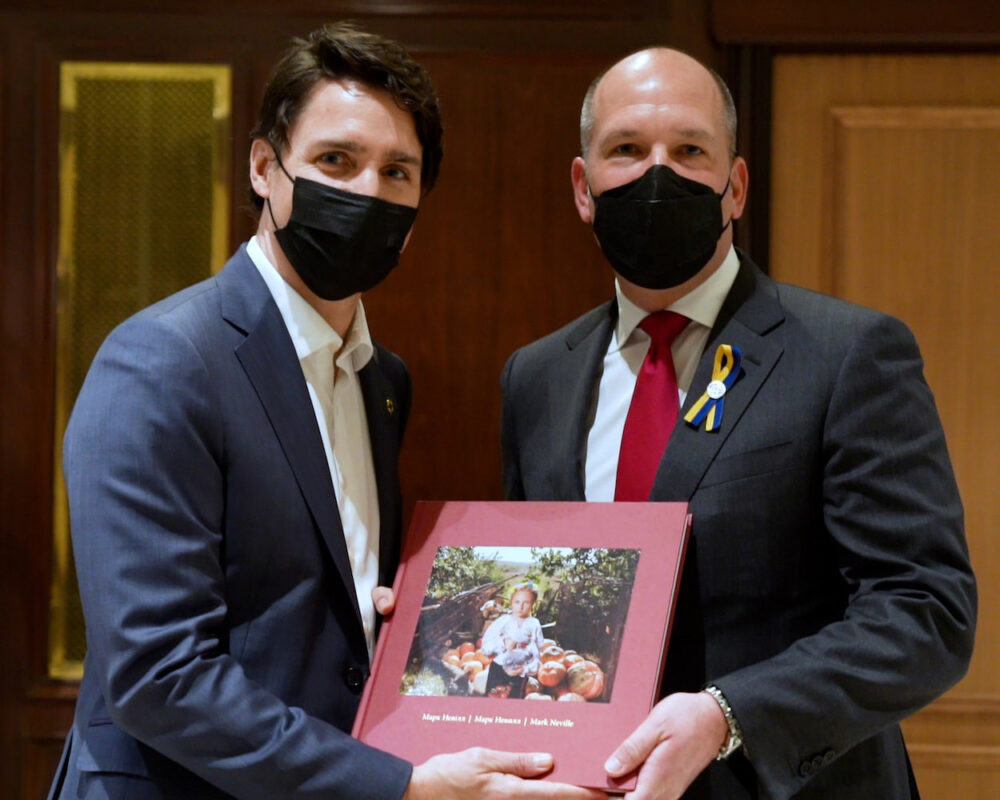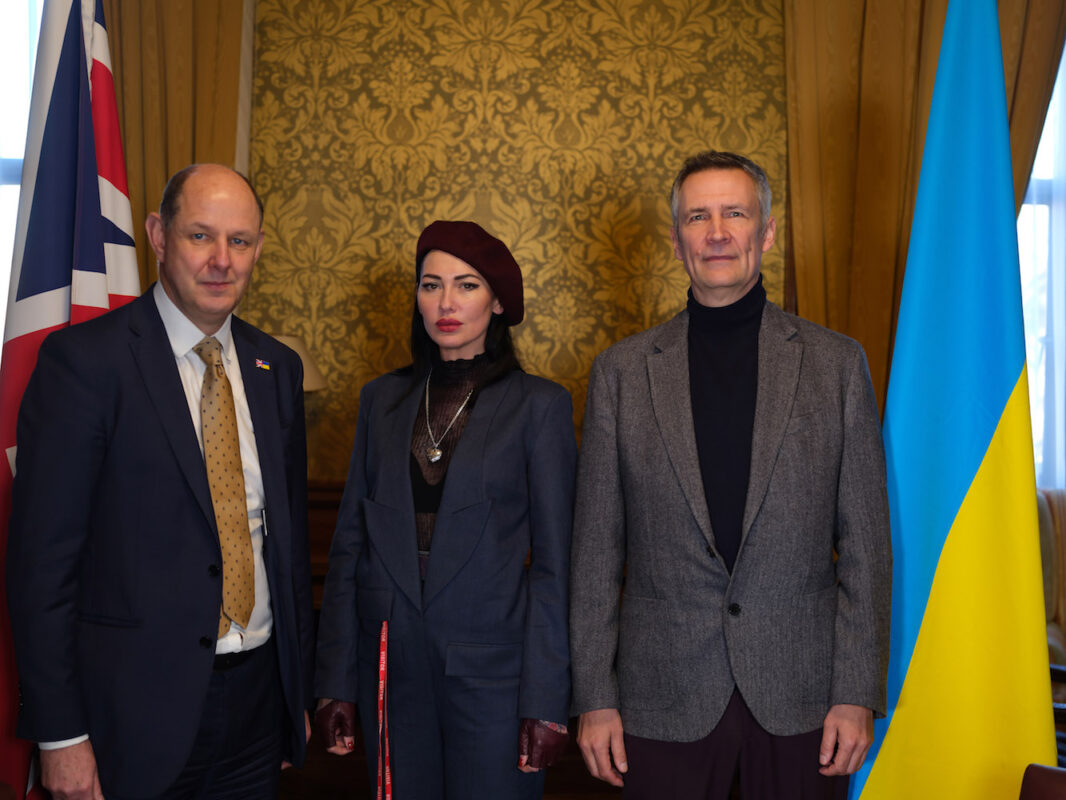Art and Aid
Postcode Ukraine
Mark Neville
As a British artist living and working in Ukraine, Mark Neville shares an account of his experiences in a country that has now been under siege for more than 500 days. Known for his long-term, immersive documentary projects in various places, from Glasgow to Helmand Province, Neville reflects on reconciling the urge to document what is happening in his adopted home with the waves of grief, fear and horror felt as the war has unfolded in real time.
In 2011, I made a long commission for the Andy Warhol Museum in Pittsburgh, where I decided to focus on racial inequalities in American society. When these photographs were later shown at the Cristea Roberts Gallery in the solo exhibition London/Pittsburgh, we approached the Scottish-Sierra Leonean writer Aminatta Forna to write the catalogue essay. One of the first things which Aminatta brought up when we met for the first time was her charity work. In 2003, Aminatta had established the Rogbonko Project to build a school in a village in Sierra Leone, the country in which she was raised. The school is now 20-years-old and her charity also runs a number of projects in the spheres of adult education, sanitation and maternal health. Our first meeting made a big impression on me; it seemed to me that her humanitarian work was integral to her, and connected to her writing. Somehow, the two activities were interwoven.
I began to more fully understand Aminatta’s desire to contribute to a people through charity or volunteering work when I first visited Ukraine in 2015 (I later moved there in 2020). Volunteering is extremely common in Ukraine, and it has been since Russia’s war began there in 2014. Some people started donating a percentage of their humble wages to soldiers, whilst others went on self-organised, self-funded aid missions delivering food, cigarettes and clothing to an extremely brave but poorly equipped frontline Ukrainian army, living in the trenches in Luhansk and Donetsk. When the war escalated on 24 February 2022, I found myself completely ill-prepared for the doubt it would provoke in me. For the first time in my life, I felt photography as a primary response to be utterly futile. Having campaigned for over 20-years on the social function of photography and how it is incumbent on photographers to use every aspect of image making and the art world as tools to change society, suddenly I felt that taking a picture was completely inadequate.
I remember waking up in my apartment in Kyiv at 7am that day to the sound of sirens. Then started the continual torment that I would be wracked with for the rest of the year. A nauseating guilt about the best course of action. Whom should I help first and how? Should I help Ukraine? Help myself? Help my partner Lukeriia and her family? Or help my friends – many of whom were male photographers forbidden to leave Ukraine because of the conflict? War makes you question exactly what responsibility means to you, and you find yourself immediately confronted with very tough decisions as to what to prioritise. Should I stay and take photographs as Russian tanks advance past my window in central Kyiv? (They never did). Should I start making Molotov cocktails, pick up a gun and join my fellow Ukrainians? Should I donate blood? Do interviews for the international press where I try to explain the situation from my perspective? Try to get work for my impecunious Ukrainian photojournalist colleagues? Or leave Ukraine and get Lukeriia to safety in Poland?
During the first week of the war, I was extremely alarmed by a second kind of invasion: the international press and media. So much so that I was prompted to post on social media a message that went viral. ‘World press and media. I have a Ukrainian press pass. I live in Ukraine. My friends live here too. Instead of sending more and more and more reporters from abroad, who do not understand the situation, or the language, or how to move around, contact me and either I will do it for you for no or little money, or I will connect you with amazing Ukrainian photographers who will do a better more accurate job than any of us. Have some respect for these people, this country and this conflict; let us get it right for you, and do not risk more lives by sending crews from abroad. Thank you for all your amazing work and continuing to report on this.’
To my relief, my words were embraced and I was inundated with messages from the world press requesting lists and recommendations for Ukrainian photojournalists and reporters. During war, most people’s incomes come to a dramatic halt. Redirecting hundreds of thousands of dollars flying reporters from New York or London to Ukrainians on the ground instead was not only the right thing to do from a journalistic and an ethical view point, but it was also quite literally a lifeline for many of my friends and colleagues in the photographic community here.
That first day of the war was exceedingly tough. Lukeriia is a very resilient woman, but her underlying health issues mean that extreme stress can be life threatening. At the end of the day, she said to me: “Mark, get me out of here.” We succeeded in catching a 24-hour-long car ride with five others in a van to west Ukraine, and then a week later, in early March, we crossed the border as refugees with thousands of others into Poland. But the guilt I felt on that first day of war just got worse and worse until it was an excruciating scream. I had only lived in Ukraine since 2020, but being forced to leave in this dramatic way, I soon realised that it had become my home, and that I did not intend to give it up. I had searched for that feeling of belonging to a community most of my adult life – as is evident in my long, immersive projects in different places – and it took me by surprise when I felt it for Ukraine.
With abject horror and protest from Lukeriia, I told her in March that I was going to return to Kyiv to try and retrieve my camera equipment and any possessions of hers she wanted from our apartment, take some new photographs, and then safely return to her in Lublin, Poland, where we had rented a small Airbnb. Although it was a terrible experience for Lukeriia, during which she imagined the worst and nearly did not sleep for the 10 days I was away, for me it was a healing experience. I travelled with an aid convoy from Warsaw – effectively a passenger coach rammed full of diapers, baby milk, toys, blankets and things which the incredibly generous Polish people had donated to Ukrainians in need. Apart from two drivers, I was alone on this bus. At the time, Kyiv was surrounded on three sides by Russian troops and everyone was concerned for my safety. The drivers were visibly nervous about going, and the Warsaw-based aid workers who loaded the bus treated me as if I were heading to certain death. This was my first experience of humanitarian aid work. People volunteering to help other people, directly, unfunded, uncelebrated, anonymously, with no virtue signalling, no selfies and no prospect of reward. Some of those people involved in organising that trip later died from Russian shelling.
I made it back to my apartment in Kyiv. I entered and saw a half-eaten sandwich on a plate, a half-drunk cup of coffee, the normal mess of life suddenly interrupted. I was euphoric. I suddenly felt able to process the trauma of being forced to leave my home and abandon my humble possessions. All those feelings began to palpably subside. The cycle of constantly re-living that day and week of panic in my mind eroded, and I felt that in some small way I had regained my identity and reclaimed myself. By returning to Kyiv, I was fighting the enemy and standing up for myself and my rights. Kyiv itself was utterly desolate at the time – no traffic, abandoned cars, very strict curfews, supermarkets barely operating, a mass of roadblocks and block posts and the occasional sound of explosions and gunfire. But I knew what I had to do.
I returned to Lukeriia 10 days later, leaving the bulk of my camera equipment at the home of one of the aid workers in Warsaw, in my mind planning that I would somehow return to our home in Kyiv via Warsaw. Then, out of the blue, an art collector family, collectors of my photographs and recipients of my pre-war book Stop Tanks With Books (2022) contacted me and asked: “What can we do to help?” Of all the recipients of my book, ranging from the super-rich, international media and NATO members to celebrities, politicians and world leaders, they were the only people who actually came forward and offered help in real terms.[Images 5 and 6] The concept behind Stop Tanks With Books had been to weaponise the medium of the photobook, to galvanise the West into supporting Ukraine’s fight for independence before the war began. Now, I felt for the first time that the model I had been using for 20 years – making photo books and sending them out for free to a targeted audience in order to change the world – was impotent, that art alone could not change anything. Just making photographs of life in wartime Ukraine was not in itself enough anymore. Of course, the atrocities committed at Bucha, in the Kyiv region and all over Ukraine needed to be documented and seen as testimony for the rest of the world to understand that this is a genocide. That documentation is the job of reportage, but not necessarily of witness art.
Apart from very occasional commissions, I am not a photojournalist employed by a newspaper. Some of the reporting I see on Ukraine has had serious limitations and impacts. Dependent on sales and audience interest, Western media’s engagement with Ukraine dropped off a cliff edge as soon as compassion fatigue set in and the public’s appetite waned. Photographs of war crimes committed at Bucha were deeply shocking and important and the West needs to try to understand that such atrocities have been committed all over Ukraine. But the images also acted as trauma pornography, leading the viewer to a dead-end cycle of re-viewing and re-engagement, but not offering hope, or solution, or respite, or a way to process the events. Fear sells content, and, since February, I have been approached by some international publications wanting me to report for them in ways which focus on fear, rather than on a more objective take on reality of life in Kyiv now. This is not to say that fear does not play a part in our lives in Ukraine, but many other things are happening which are not reflections of fear nor defined by it. Prior to the invasion of 2022, some Western newspapers, intending to generate fear, happily perpetuated Kremlin myths that described Ukraine as a fascist state. The reality is that Ukraine is one of the most tolerant countries in the world. And now, following the invasion, Ukraine is being framed once again through a prism of fear. But the reality of life here is more complex, human and nuanced, and that makes it fascinating.
Now convinced that art and photography alone were not enough – that my pre-war book Stop Tanks With Books had not accomplished enough – I proposed to this incredible, altruistic family of collectors of my work something which combined humanitarian aid with my various forms of documentary photography. To my amazement, they agreed to fund the charity project, making substantial donations to the aid groups we support on a regular basis. This has meant that any donations from others that we receive go directly to those in need, not on the running costs of the charity itself. This project represents the logical conclusion and culmination of my life’s work; the investigation into how photography, and the photographic community in all its elements, including collectors, can and should significantly impact in the real world. After all, photography deals with the real in a unique way and therefore it should aspire to something more than virtue signalling, something which equated to the courage of those Polish volunteers who delivered both aid and me to Kyiv in March.
In April, I returned with Lukeriia to Kyiv, and constructed a hybrid project which fused a type of “guerrilla giving” – one which responded to the immediate needs of Ukrainians on the ground in the worst affected towns and villages, with my efforts to document the reality of life in Ukraine in a way which might make the West re-engage with my adopted home. Together with co-founder Tanya Logacheva, I devised the Postcode Ukraine project and we started by helping other grassroots Ukrainian charities deliver food and medical supplies to seven villages in the Chernobyl region: Ivankov, Sukachi, Krasyatychi, Maksymovychi, Sichivka, Dimer and Dimidov. We then went on to visit villages through Kyiv, Chernihiv, and Kharkiv regions. Paying for petrol, food and medical supplies, we would accompany volunteer groups and charities, many of whom had been working since the first day of the war without rest or wages. Two things struck me during that initial month of the project. The first was the complete lack of support for people who had lost everything. One realised pretty quickly that without these humanitarian aid deliveries, many people would not survive. There was no other support network in place. We could, and indeed do, make a difference. The second impression was the type of devastation wrought by the war. Everywhere we travelled, we found destroyed schools, kindergartens and nursery schools. Children had been deliberately targeted and this was clearly genocide. The Russian army had come very close to capturing the capital and the burnt-out carcasses of Russian tanks were found within ten kilometres of Kyiv city centre.
A game changer for us came in July when the family funding our project demonstrated astonishing commitment by visiting and accompanying us on a tour of Ukraine to see the challenges for themselves. This was hugely beneficial to the project. I had no previous experience of running a charity, and this family had plenty. They suggested a powerful structure for Postcode Ukraine. Rather than be the ones who spent our time packing up boxes of food and attempting to locate the ever-changing frontline demographics in need, we would try to identify the charities in Ukraine already doing the best work, the ones who would most benefit from our support, the ones with a network of volunteers and managers already in place. It made sense. We visited and assessed charities and encouraged them to submit funding proposals for projects. We thus became a “charity of charities”, funding the organisations that employed the best practice, charities which were transparent with their book-keeping, charities with some kind of long-term sustainable plan and, importantly, charities with some strategies in place to help overcome the burn-out and exhaustion that the aid sector in Ukraine has been experiencing. Postcode Ukraine has donated well over $200,000 to humanitarian aid groups, including Go Kultura Demokratti in Odesa, who receive and help around 600 families a day fleeing heavily targeted regions such as Zaphorizhzhia and Mykolaiv.. Volunteer 68 have been evacuating people from frontline towns since the war began in 2014, and delivering food and medical supplies to 12,000 people a month in the Kharkiv region. I regularly accompany the charities that Postcode Ukraine supports on their missions and we all stay in regular contact. They ask us what we can provide and then we in turn ask them what they need, requesting them to submit budgeted project proposals, followed by receipts and reports.
Added to this, I am also constantly in touch with all manner of aid groups and supply chains which deliver to Kyiv from all over the world. I never leave Kyiv unless my car is full of generators, thermal clothing, sleeping bags, toys, medicine or food and I never go empty-handed to frontline towns in Kherson, Bahmut or Kharkiv. Sometimes I am accompanied by a military escort, but on days like today, I am just with my regular driver, Yuri, as we deliver blankets and thermal underwear to a frontline military hospital in Kherson. The most deeply shocking and dangerous of these aid trips was one I made in December 2022 to deliver generators to Bahmut. The continual sounds of explosions – by continual, I mean one every few seconds – did not stop throughout the day. Having suffered from PTSD as a result of working as a war artist in Helmand, Afghanistan in 2011, I now take my own mental health very seriously and closely monitor my behaviour after embarking on aid missions. We are all just vulnerable animals, no matter how resilient we believe ourselves to be. One British army officer illustrated my feelings perfectly when I told him that I felt I had changed since returning from Helmand: “If you were to put a cat in a field, and you let off bombs all around the cat over the course of several weeks, the cat may well survive but it won’t be the same cat anymore. It is the same with people.”
My relationship with Ukraine started in 2015 when Kyiv Military Hospital requested (Ukrainian language version) copies of my book about mental health in the British military, Battle Against Stigma (2015). I was so impressed that a “post-Soviet” country would be so forward-thinking in its desire to treat its soldiers that I had the book translated into Ukrainian and sent it to them as a PDF. Shortly after, I visited Kyiv and the hospital and met some of the soldiers who had returned with both physical and psychological wounds from the war in the East. In 2016, I then started visiting Ukraine’s frontline towns and trenches and began work on the content for Stop Tanks With Books.
Throughout 2017, I travelled through Ukraine making new work for the Centre for Eastern European and International Studies in Berlin, focusing on the estimated 2.5 million internally and externally displaced Ukrainians resulting from the war in the Donbas. It was during the making of Displaced Ukrainians in 2017 that I fell in love with this country. I interviewed countless families who had been forced to flee their homes in Donbas, who had witnessed and experienced unimaginable horror, and who literally had nothing left; no possessions, no security, no income, no pension and no hope. Yet, not once did any one of them ask me for support, nor for financial assistance. They just wanted to tell me their story. I have worked in some very difficult environments in the past, where people are going through absolute hell, and I can testify with experience that the kind of resilience I saw amongst Ukrainians during the making of that project is exceptional. When I returned to London in late 2017 after completing Displaced Ukrainians, I realised that I was not the same person any more, that I had learnt something important from these people.
In 2020, five years after my first visit to Ukraine, I moved from London to Kyiv. In order for me to realise the Stop Tanks With Books project, I needed to understand how it feels to call Ukraine my home, to live at the geographic centre of Europe and feel war rumbling away on one’s borders as a daily reality, and to live with the threat of a further, full-blown Russian invasion at any moment. From the start, I understood how this threat has devastated not just those displaced from Crimea or Donbas, but how it has destabilised the whole country, and how deeply unsettled people feel. Relocating has also allowed me to see my country of origin, Britain, with greater objectivity. Many of the obstacles which Ukraine faces also now face the UK. The impact of pro-Kremlin disinformation has been an extremely destructive force there as it has been here, and a disastrous, growing lack of transparency and accountability amongst the different branches of power within British government has clearly facilitated Kremlin influence upon everything from Brexit, to banking and real estate deals, not to mention the enabling of money-laundering.
Now it is 2023 and I am director of a charity in Ukraine. Being an integral part of a humanitarian aid project is important to me for a number of reasons, but primarily because it immediately changes my relationship to the people who are my subject matter as a photographer. Rather than being someone flown into Ukraine by an international newspaper or media outlet – perhaps with a predetermined story to tell – I am actually someone who is helping locals in tangible ways. My role is very clearly one focused on aid rather than on documentation of others’ misery no matter the cost. By accompanying aid missions, which we are supporting on every level, including logistics, funding, and transportation, my role has changed. These people living in the frontline towns have lost everything. They have seen their friends and families slaughtered and their homes levelled. And yet everyone wants to take something more from these people. Journalists come and go from all over the world asking these people to re-engage with their trauma as they recount the abject horror they have lived through. So, you can be damn sure that, when we turn up, the very least we offer people something, no matter how small: packs of apples, bunches of bananas, cigarettes, bags of candies, chocolate bars, toys, tools. It is essential that these people see that someone is gifting them something, that not everyone who records their lives is purely wanting to take from them with the sole justification that they are keeping their fight in the news. It sounds obvious, doesn’t it? But, mostly, this does not even occur to most people coming to work in a war zone. The emotions which I felt around this issue were conflicting and torturous as I attempted to reconcile the urge to document what was happening to my adopted home with the waves of grief, fear and horror I felt as the war unfolded in real time. It continues to impact my home, my quotidian life, my partner, her family, my friends, my colleagues, acquaintances and ultimately upon me too.
Somehow, I have always come back to the same question for two decades: how can the subjects of my photographs become the primary audiences and beneficiaries of the images over and above visitors to art exhibitions, photo book collectors and generic audiences. This started with my The Port Glasgow Book Project (2004) nearly 20-years ago – a book containing my photographs of a town on the west coast of Scotland, which was delivered uniquely to every home in the Port, all 8,000 of them, by the local boys’ football team. The book was never made commercially available in bookshops, online or anywhere else. The idea had been to disrupt the conventional hierarchy of exploitation normally found in the way these art books always ended up on the coffee tables of white, middle-class people like me, and not on the coffee tables of those represented in them.
With Postcode Ukraine, the concept was to shift the role of the conflict photographer away from reportage for newspapers in the West. Instead, the emphasis is one where I have a kind of exchange with Ukrainians during their hardest times, one which is focussed primarily on delivering aid, not on making news content. That changes the type of photographs I am able to capture, the willingness of my subjects to participate in this process and their feelings about featuring in my images. This in turn has made me feel more comfortable about taking images and I hope it allows me to make more intelligent work. Images are taken, and then usually taken again to reach audiences other than the subject matter. That process necessitates giving something back.
Not only that, but my personal feelings about living in Kyiv during this war needed to be reflected in my images. I am not making reportage; I am not telling the news. I am somehow trying to express my quotidian experience of living with the war through the photographs. The juxtapositions I see between the banal routine of normal life and the horror and insanity of the genocide are absolutely perverse. I live in Ukraine because I truly love it here. My residency is not an experiment, artistic or otherwise, as it was in Port Glasgow. But living here at this moment is also an act of defiance, a political statement which proclaims that I am part of a demographic that refuses to be beaten by the Kremlin. I believe that if enough people stay in Ukraine, then we have won. That is not to say that people who leave Ukraine are somehow weaker, or are defeated, or are not fighting in equally important ways. They are. Nevertheless, it is shocking and indeed traumatising on some levels to normalise an existence which is bookended by explosions, sirens and random, malevolent acts of violence. For the first time, I have started making black-and-white photographs on a consistent basis in order to create surreal stages for these juxtapositions. The images I made for Postcode Ukraine are inspired by literature rather than film, photography or painting. Kurt Vonnegurt’s Slaughterhouse 5 (1969), J.G. Ballard’s novels and Martin Amis’ House of Meetings (2006) all created absurd and cruel worlds defined by conflict. Ballard summed it up: ‘I don’t think you can go through the experience of war without one’s perceptions of the world being forever changed. The reassuring stage set that everyday reality in the suburban west presents to us is torn down; you see the ragged scaffolding, and then you see the truth beyond that, and it can be a frightening experience.’
Being in-between several roles here in Kyiv is a surreal, disorientating experience in itself. I am not Ukrainian. I am not (yet) an experienced aid worker, and I am not a photojournalist. The immediacy and overload of graphic images covering this war on social media has been unprecedented. I often feel like my own voice is taken away from me by the over-mediatisation of the war. For example, at 8:20am on Monday 10 October 2022, a Russian shell hit a playground in Shevchenko Park, a two-minute walk from my home. I was making coffee at the time and I heard not just the huge explosion, but the missile flying directly over my kitchen moments before it hit. And it was this sound, of it flying overhead, that was absolutely terrifying, even more so than the sound of impact. My first impulse was to get Lukeriia, who was asleep in bed at the time, to safety. I took her to the bathroom and we sat on the floor for several minutes. My next impulse was to leave the apartment and take my camera and flash equipment out on the streets and find the place of impact. Lukeriia screamed at me not to do so, perhaps with some justification as moments later there was a second explosion, then a third, a fourth and a fifth. About an hour later, I convinced Lukeriia that I could and indeed must leave the apartment to document this attack on us. However, by the time I reached the location of the first missile strike, it was already heavily cordoned off and controlled by military and police. International press and media crews were already in place on its perimeter, and the dead and injured had been taken away. So, this written testimony of the attack becomes the primary record of the event for me, an experience of terror but also one of frustration. Two days later, even the huge crater where the missile impacted had been completely filled in by the local council. Much like the physical site, my memory of the missile strike was immediately filled in by the media, who presented ways for me to think and feel about it which pre-emptied my own response. I somehow felt robbed of the opportunity to process the event on my own terms. Trauma works on the body as well as on the mind, and apart from some minor disorientation and hypersensitivity, I felt absolutely fine for about three days following the strike. Then someone asked how I was and I wept. I realised that I was not fine. Later, I tried to represent my response to this missile strike in a portrait of a schoolboy standing amidst the remains of a destroyed building further away in the Kyiv region.[Image 1]
When I saw children from Bogdanovka, near their burnt-out school bus, I had the feeling these children were ghosts, attempting to reclaim the ruins of the school that the Russian army blew up and mined during their retreat, following a month of occupation.[Image 2] I live with these perverse visual juxtapositions everyday. The portrait of Tatiana was taken 200-metres from my front door, during a display of seized and destroyed Russian tanks on Khreschatyk High Street, Kyiv this August, to commemorate the 31st year of Ukrainian independence.[Image 3] 19-year-old student Tanya looked to me like a character from a Luc Besson film – a cross between an activist and an angel. Behind her is a trophy of war, a burnt-out armoured personnel carrier left behind by the Russian invaders who tried to capture her hometown of Shostka, not far from Sumy. Many of my other images feature the recipients of aid on our missions, and one particularly distressing aspect of these trips is how often we find single mothers having to care for two or more children at the same time, as they face homelessness, displacement and utterly paralysing fear at what the future holds.[Image 4]
My aim with Postcode Ukraine is not just to deliver humanitarian aid and take photographs. I try to present the images in resonant contexts to compassion-fatigued Western audiences. I hope to encourage those audiences to re-engage with Ukraine, but success or failure in this respect is a hard thing to quantify. The V&A in London immediately responded to a proposal to exhibit large prints and copies of the book Stop Tanks With Books. They received our proposal in late March 2022 and, with speed unheard of for a large institution, succeeded in printing, framing, installing and promoting the entire exhibition within three weeks. They recognised the urgency and decided to respond to current events in the same activist spirit as Stop Tanks With Books and Postcode Ukraine. When the show ended in September, it was only two months before we then managed to place the work at The Foreign, Commonwealth and Development Office in London.[Image 7] The civil servants at FCDO understood that this was an opportunity to weaponise an artwork whose messaging about Ukraine aligned with its own and they pulled out all the bureaucratic stops to make the exhibition happen. Putting the work in a place visible to many key stakeholders reminds the international community of the people in Ukraine in a very specific way. I now see charity work and my practice as interwoven activities. ♦
All images courtesy Mark Neville and Postcode Ukraine.
—
Mark Neville is a British artist who has been living and working exclusively in Ukraine since 2020. Stop Tanks With Books was shortlisted for both Les Rencontres D’Arles Photobook Award and Paris Photo–Aperture PhotoBook Award 2022, and chosen as the best art book of 2022 by The Art Newspaper.
Images:
1-‘Schoolboy, the Kyiv region’, March 2022 © Mark Neville.
2-‘Bohdanivka, the Kyiv region, the school and the school bus were deliberately targeted by Russian artillery’, June 2022 © Mark Neville.
3-‘Display of seized and destroyed Russian tanks on Khreschatyk High Street, Kyiv’, August 2022 © Mark Neville.
4-‘Preparing to leave’ August 2022 © Mark Neville.
5-‘Demonstration of European Parliament members, Brussels’, 2 March 2022. Photographer unknown.
6-‘Justin Trudeau receives his copy of Stop Tanks With Books’, April 2022. Photographer unknown.
7-‘Mark Neville with Lukeriia and Sir Philip Barto, the Foreign, Commonwealth and Development Office, London’,18 January 2023 © Lukeriia Pokrovska.

